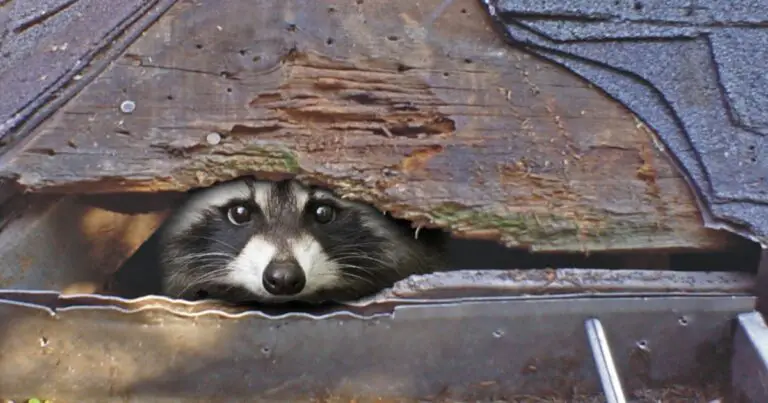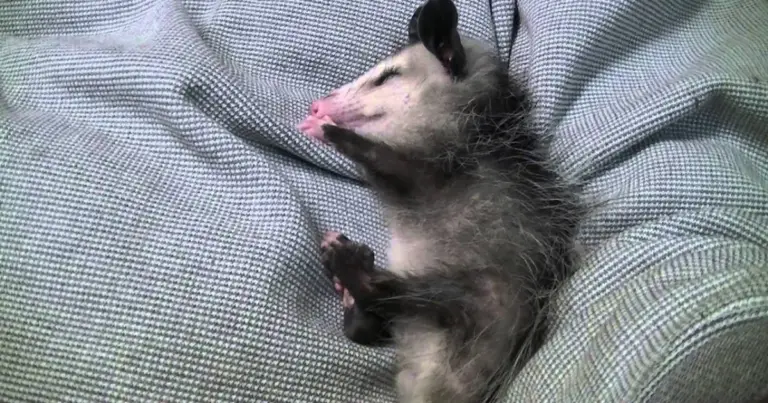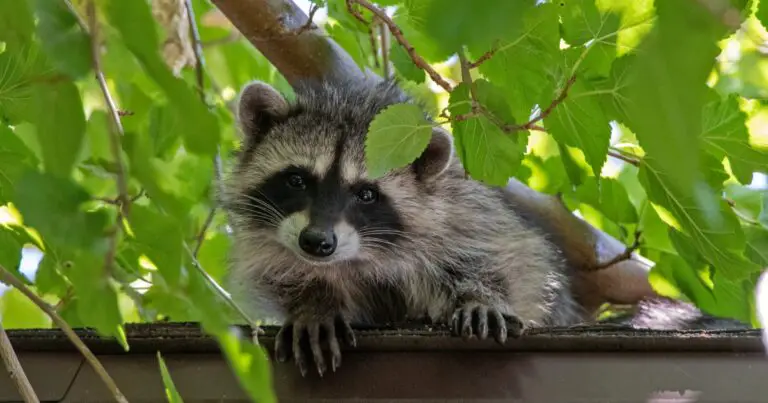How to Tell If a Raccoon Is Living in Your Attic
If you think that you may have a raccoon living in your attic, there are signs you can look for to confirm your suspicions. Raccoons are opportunistic animals, and they will take advantage of any opportunity they find to make themselves comfortable.
If you see any of the following signs, it’s likely that there’s a raccoon in your attic and you should call a professional wildlife removal service:
- Noise coming from the attic – especially at night
- Time of day that you hear noises
- Evidence of raccoons nesting in the attic, such as shredded insulation or chewed wires
- Damage to your roof, eavestrough etc.
- Seeing raccoons around your home
Noise Coming From The Attic
Raccoons are typically the biggest creatures you’ll encounter in an urban environment. The noises they make are easily distinguishable as those of a bigger creature due to their size and weight. If you’re hearing thumping sounds, it’s an indication that a raccoon is on the premises. There are no other urban pests that make stomping noises. Squirrels will scamper and bang around, but a raccoon truly will sound like a little human is climbing about.
They are loud, particularly when their young are in the mix. When their pups are around, the mothers become much more vocal. When they aren’t sleeping, the tiny ones usually scream.
Another one of the frequent indications that a raccoon is in the attic and on its way back to its nest is what sounds like something walking across the roof. This mostly happens at night.
Time Of Day & Season
The time of day that you notice the activity is the next best indicator to prove that you’re dealing with raccoons. Raccoons are nocturnal, and the most common time they try to get access to a building is late at night or during the night.
The time of year is also an element to consider. The baby raccoon season lasts from late winter through early spring, when it peaks around the month of March. Attics, sheds, and garages are all good hiding places for moms seeking for a warm place to have their young. After the youngsters are born, the raccoon family will stick around for a while longer; it generally takes three months for babies to develop strong enough to walk. As a result of these reasons, you should be especially careful during the spring.
If you start taking measures to kick the raccoon out within the first 24 hours, it could stop her from birthing in your attic and taking up residence to care for her young.
If you hear crying or high-pitched squealing coming from your attic during this season, there’s a good chance an adult female raccoon is there with her offspring. The sound of babies calling for their mother can be heard if you listen to the wail of a newborn.
Finding Nesting Materials
If you find raccoons on your property, search around for any nesting materials. Raccoons will seek out areas to make themselves at home almost instantly, using everything they can get their hands on. They are quite inventive, and they will utilize just about anything to create a nest for themselves.
They’ll bring in a lot of outside things, such as leaves and twigs, but they’ll also destroy insulation and cloth in the attic to make bedding for themselves. If you see twigs and leaves strewn about or shredded cloth and paper throughout the room, this is one of the most typical raccoon signs.
Visible Damage To Your Home
To provide an example of the size factor with these animals; raccoons can wreak havoc in a short amount of time. They have sharp teeth and claws, which they will use to gnaw through wooden supports beams, roofing tiles, and drywall. Look for any obvious signs of property damage to the walls, floor, and ceiling of
If a raccoon is trapped and panicking, it will rapidly destroy your attic. Even if it’s just taking refuge and isn’t trapped, a raccoon can damage your insulation, wiring, structural beams, and HVAC components.
The damage caused to insulation may be a disturbance as it is needed to keep your home warm. But when it comes to damage the structural beams that underpin your property, things become a lot more serious.
Raccoon Sightings
Even if you haven’t seen a raccoon in your attic, one may have been on your property. It could be rummaging through your trash can or climbing up or down your downspout. Perhaps you’ve seen one scaling up or down your downspout, or maybe you’ve noticed one on the roof. These are all indications that they could be dwelling in your attic.
Don’t underestimate raccoons if you’ve noticed any of these signs. Raccoons are a nuisance. They’re dirty and smelly. Furthermore, they are carriers of deadly parasites like Baylisascaris as well as deadly diseases including rabies.
Knowing whether raccoons are in the attic is a crucial first step in wildlife removal. Once you’ve confirmed that you have raccoons at home, you can take proactive steps to remove them and any of their young in a humane fashion. Then you can begin to clean, restore the attic and any damages, and take preventative measures to ensure that no raccoon gets in in the future.
How Do Raccoons Get Into Your Home?
Here are some of the most frequent ways that raccoons get into your home, as well as some tips on how to get rid of them.
Through The Edge Of Your Roof
Raccoons tear through the house’s roofline as a common way to enter your home. The meeting of the home and eavestrough is a favorite entry point for raccoons. All melted snow and rain must flow through the roof’s edge to reach the eavestrough by design.
Because of the severe climate and the high amounts of moisture, the roof’s edge gets worn and deteriorates faster than other parts of your roof. As a result, it’s quite simple for an opportunistic raccoon to gnaw or cut through rotten wood in order to gain entry into your house.
Destroying The Roof Vents
Raccoons have little trouble removing the aluminum or plastic roof vent cover. Because raccoons can feel the wind that escapes through these vents, they may be tempted to get in and enjoy it. They’ll work hard to get into there since this is where the warmth is coming from.
Flimsy Roof-Soffit Intersections
The areas of your roof where the soffits sit above the section of the roof are known as Roof-soffit intersections. These intersections are generally found at the point where the top and bottom roofs meet. Raccoons are able to get into the soffits since they’re made of thin plastic or aluminum. All that is required for the raccoon is to utilize its shoulders to pry open these flimsy soffits in order to access the attic.
Squeezing Through Plumbing Mats
On the roof vents that connect to your plumbing system, pluming mats are used to eliminate sewer gases. When pipes are ran through roofs, the big opening cut in the rooftop to extend to the pipe is generally made larger than the pipe itself so it’s easier to transport the plumbing along. To conceal large gaps created by these holes, rubber mats are often used.
Raccoons are tenacious, and they can shred and tug at these mats until they create large enough gaps to squeeze through. They then plunge down the hole, right into your attic, to make themselves at home.
Tips For Around The Home
We must take a more comprehensive method to general preventative measures when dealing with raccoons, as they are bright, nimble creatures that are also opportunistic feeders with a diverse diet.
Clean Up
Raccoons can get access to areas all around your home, making themselves at ease while causing all sorts of damage. It’s critical to keep the surroundings surrounding your property clear and free of nooks, crannies, and sheltered areas where raccoons could nest. Keep tree, rock, or stump sites away from your property and free of debris if possible. If not, keep them unsheltered and clear of rubbish.
Remove All Possible Sources Of Food
If possible, keep your garbage cans closed and stored in a shed or garage. Check to see if any fallen edible items have been cleared from the area surrounding your home. If there are a lot of pests in the neighborhood, removing your birdfeeder might help reduce the number.
Raccoons, being adaptable animals that have learned to coexist with humans, are known to open trash cans and sift through the contents. A big lid for your compost or garbage can will make it more difficult for the creatures to damage your yard and home.
Trim The Trees Around Your Home
A tree’s long branches that extend toward your house may act as an easy entry point for curious animals. To make roof access more difficult, keep your tree branches trimmed and away from the home. A fruit or nut tree might provide meals around your roof that are attracting unwanted animal visitors to your property.
Contact Wildlife Removal Experts
It’s time to contact a local humane wildlife removal business now that you know what to look for and what not to do. With a one-way door, the company will remove the raccoons from your home in a safe and effective manner, ensuring that no baby raccoons are left behind; it will also seal all entry points to prevent raccoons from coming in the future, and help with decontamination and repairs.
When it comes to protecting your property from raccoons, you don’t have the time for trial and error. Act immediately by calling experts.
Conclusion
Raccoons can be a tricky animal to deal with, so it’s important to know signs that there’s a raccoon in your attic. With their strong sense of smell, sharp claws and teeth, and the ability to quickly adapt and learn new tricks; they are not an adversary you want poking around inside your home.
Hopefully these signs that there’s a raccoon in your attic will help guide you toward calling for professional assistance before any more damage is done!







One Comment